
GPRS refers to a high-speed packet data technology which is expected to be deployed in the next year. It is expected to profoundly alter and improve the end-user experience of mobile data computing, by making it possible and cost-effective to remain constantly connected, as well as to send and receive data at much higher speeds than today. Its main innovations are that it is packet based, that it will increase data transmission speeds from the current 9,6 Kbps to over 100 Kbps and that it will extend the Internet connection all the way to the mobile PC - the user will no longer need to dial up a separate ISP. GPRS will complement rather than replace the current data services available through today's GSM digital cellular networks, such as circuit-switched data and short message service. It will also provide the type of data capabilities planned for 'third generation' cellular networks but years ahead of them.
Why is GPRS important?
The most important aspects of GPRS are that it allows data transmission speeds to over 100 Kbps, that it is packet based and that it supports the world's leading Internet communications protocols, Internet Protocol (IP) and X. 25.
The fact that GPRS will operate at much higher speeds than current networks should provide a huge advantage from a software perspective. Today, wireless middleware is often required to allow slow speed mobile clients to work with fast networks for applications such as e-mail, databases, groupware or Internet access. With GPRS, wireless middleware will often be unnecessary and thus it should be easier to deploy wireless solutions than ever before.
Whereas today's wireless applications tend to be text oriented, the high throughput offered by GPRS will finally make multimedia content, including graphics, voice and video practical. Imagine participating in a video conference while waiting for your flight at the airport, something completely out of the question with today's data networks.
Why is packet data technology important? Because packet provides a seamless and immediate connection from a mobile PC to the Internet or corporate intranet allowing all existing Internet applications such as e-mail and Web browsing to operate smoothly without even needing to dial into an Internet service provider. The advantage of a packet-based approach is that GPRS only uses the medium, in this case the precious radio link, for the duration of time that data is being sent or received. This means that multiple users can share the same radio channel very efficiently. In contrast, with current circuit-switched connections, users have dedicated connections during their entire call, whether or not they are sending data. Many applications have idle periods during a session. With packet data, users will only pay for the amount of data they actually communicate and not the idle time. In fact, with GPRS, users could be 'virtually' connected for hours at a time and only incur modest connect charges.
While packet-based communications works well with all types of communications applications, it is especially well suited for frequent transmission of small amounts of data, what some call short and bursty, such as 'realtime' e-mail and dispatch. But packet is equally well suited for large batch operations and other applications involving large file transfers.
GPRS will support the widely used Internet Protocol (IP) as well as the X.25 protocol. IP support is becoming increasingly important as companies are now looking to the Internet as a way for their remote workers to access corporate intranets.
The IP protocol is ubiquitous and familiar but what is X.25 and why is support for it important? X.25 defines a set of communications protocols that prior to the Internet constituted the basis of the world's largest packet data networks. These X.25 networks are still widely used, especially in Europe and so wireless access to these networks will benefit many organisations. But what does this really mean? Quite simply it means that any existing IP or X.25 application will now be able to operate over a GSM cellular connection. You can think of cellular networks with GPRS service as wireless extensions of the Internet and existing X.25 networks, as shown in Figure 1.
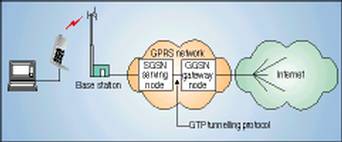
The user experience
We now look more closely at how the user takes advantage of GPRS. We have already emphasised the packet nature of GPRS which makes a GPRS connection similar in many ways to a local area network (LAN) connection. Just as with a LAN connection, once a GPRS mobile station registers with the network, it is ready to send and receive packets. A user with a laptop computer could be working on a document without even thinking about being connected and then automatically receive new e-mail. The user could decide to continue working on their document, then half an hour later read the e-mail message and reply to it. All this time the user has had a network connection and not once had to dial in, as he or she must today with circuit-switched connections. Furthermore, GPRS allows for simultaneous voice and data communication, so the user can still receive incoming calls or make outgoing calls while in the midst of a data session.
Since there is almost no delay before sending data, GPRS is ideally suited for applications such as extended communications sessions, e-mail communications, database queries, dispatch and stock updates to name just a few. In addition, the high throughput of GPRS will remove many of the obstacles from the use of multimedia, graphical web-based applications. For example, mobile users will be able to easily use graphically intensive web-based map application to get directions while travelling. Furthermore, with almost no transmission delay and high throughput, it will be more practical to use enterprise applications such as SAP wirelessly and remotely.
Platforms and GPRS
Because GPRS supports standard networking protocols, configuring computers to work with GPRS will be very straightforward. In the case of IP communications, you will be able to use existing TCP/IP protocol stacks, such as the stack that comes with Windows 95 or Windows 98, Windows CE and Windows NT. TCP/IP stacks are readily available for most other platforms as well. With all the developments in the handheld computer area, you can expect a multitude of hardware platforms to take advantage of GPRS:
* Laptops or handheld computers connected to GPRS-capable cellphones or external modems.
* Laptops or handhelds with GPRS-capable PC card modems.
* Smart telephones that have full screen capability.
* Cellphones employing microbrowsers using the Wireless Application Protocol.
* Dedicated equipment with integrated GPRS capability, eg mobile credit-card swipers.
GPRS coincides with another important technology development: the replacement of a cable connection to a cellphone by a short radio link. Intel, Ericsson, Nokia, IBM, Toshiba and others are already working on such wireless connections in an initiative called 'Bluetooth'.
GPRS and remote access
Traditionally companies have provided remote access for their workers using dial-up modem connections into corporate modem pools. But as companies have established high speed connections to the Internet and as remote workers have an increasing number of options for connecting to the Internet, companies are now looking to the Internet as a way for their remote workers to access corporate intranets. This is especially effective because most communications applications today work over IP networks - including many originally designed for modem dial-up connections. It can be highly cost effective to use the Internet instead of making long distance telephone calls and in the case of international connections, much more reliable. But this Internet-based technique does raise an issue of privacy from hackers. A new technology is emerging which addresses privacy and authentication concerns, referred to as a virtual private network (VPN).
A VPN is a method of having private communications across public networks. It adds additional software at each end of the connection - in our case the mobile computer and the corporate network. This software establishes what are called 'tunnels'. Within this tunnel, information is encrypted and additional information is added to each packet to prevent tampering. Various standards are available or being finalised to define interoperability between VPN products, including the Point to Point Tunnelling Protocol (PPTP), Layer Two Tunnelling Protocol (L2TP), SOCKS and IPsec (Secure IP). A wide range of companies already offer VPN solutions today, including router vendors, network software providers, firewall suppliers and companies specialising in this area. Since most VPN solutions are quite flexible in their feature set, corporate IT can choose the level and type of protection desired, such as 56 bit encryption or 128 bit encryption.
Almost all VPN technologies operate independently of the communications link, meaning the same VPN technology will work with a dial-up modem connection, Ethernet connections, ISDN connections and most importantly for us, wireless connections. See Figure 2.
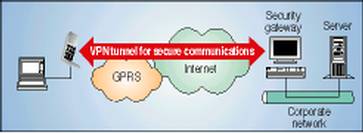
Companies using VPNs will be able to smoothly migrate from existing wireless technologies to GPRS. Today their users can make circuit-switched connections to an Internet service provider and then establish a VPN connection. Once GPRS becomes available, the Internet connection will extend to the mobile computer and the user will no longer need to dial a separate ISP. The net result is wireless connectivity that works hand in hand with VPN technologies to let remote workers easily access corporate resources and to stay in touch with their work teams.
The road map
According to Kevin Holley of the chair for the GSM SMG4 committee which develops GPRS standards, the first version of the GPRS standard is complete while a next version of the standard that adds advanced features such as point-to-multipoint communications is in development. Most GSM vendors such as Alcatel, Ericsson, Lucent, Motorola, Nokia, Nortel and Siemens have been active in the standards process and many are developing the necessary infrastructure elements. Though the GPRS standard specifies support for both X.25 and IP, it is likely that vendors and operators will emphasise IP service. It is also likely that GPRS will first roll out in European countries. Many operators are expected to deploy the service since the infrastructure cost is relatively modest. It is possible that eventually all new GSM telephones will support GPRS.
Where does GPRS fit in with other GSM data developments, as well as data capabilities for other wireless networks? The first improvement with GSM data is increasing existing circuit-switched data speeds from 9600 bps to 14,4 Kbps. The addition of V.42 bis compression over the airlink will further increase throughput by about a factor of two. After that and before GPRS is available, some carriers will begin offering high speed circuit-switched data (HSCSD) which like GPRS combines multiple voice channels to offer higher data rates. SingTel in Singapore announced in May of 1998 that using HSCSD technology it would be offering data rates of up to 38,4 Kbps.
Another development is referred to by some as 'direct IP access'. The user makes a circuit-switched data call but rather than switching the call into the public switched telephone network, the carrier terminates it at a router that is connected to the Internet. From the user perspective, the carrier appears like an Internet service provider offering dial-up service. This hybrid circuit/packet type of service is a good stepping-stone to GPRS and will also work with HSCSD.
And GSM standards bodies are already defining data networking technologies that will build upon GPRS. One such technology is called Enhanced Data rate for GSM Evolution (EDGE) which will offer a maximum theoretical rate of 384 Kbps, though normal operating speeds will be about half this rate. Beyond EDGE, third generation cellular systems will eventually offer data rates to 2 Mbps. See Table 1.
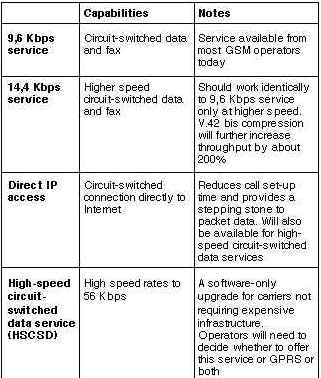
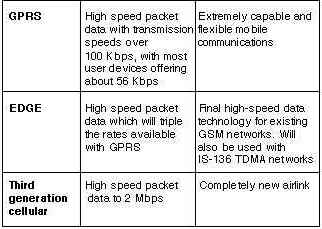
Data services similar to those for GSM are also being developed for IS-136 TDMA and CDMA networks. But as a more mature digital technology, GSM has a strong head start. When GPRS is deployed, no other wireless data technology will be able to match its capabilities. But it is also important to remember that GSM already offers excellent data and fax capabilities that provide more than sufficient capability for many types of applications. As technologies like GPRS become available, the scope of data applications that are practical for wireless connectivity will only increase.
GPRS details for network managers
To better understand GPRS, we take a quick tour beginning with the mobile PC and traversing through the network. First, we have a notebook computer connected to a GPRS-capable cellphone or modem, either through a serial cable or other type of connection such as universal serial bus (USB) or local wireless link. Or perhaps the connection device is in the form of a PC card. The GPRS telephone or modem communicates with GSM base stations but unlike circuit-switched data calls which are connected to voice networks by the mobile switching centre, GPRS packets are sent from the base station to what is called a serving GPRS support node (SGSN). The SGSN is the node within the GSM infrastructure that sends and receives data to and from the mobile stations. It also keeps track of the mobiles within its service area. The SGSN communicates with what is called the gateway GPRS support node (GGSN), a system that maintains connections with other networks such as the Internet, X.25 networks or private networks. See Figure 2. A GPRS network can use multiple serving nodes but requires only one gateway node for connecting to an external network such as the Internet.
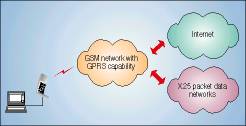
When the mobile station sends packets of data, it is via the SGSN to the GGSN which converts them for transmission over the desired network which could be the Internet, X.25 networks or private networks. IP packets from the Internet addressed for the mobile station are received by the GGSN, forwarded to the SGSN and then transmitted to the mobile station.
To forward IP or X.25 packets between each other, the SGSN and GGSN encapsulate these packets using a specialised protocol called the GPRS tunnel protocol (GTP) which operates over the top of standard TCP/IP protocols. But the details of the SGSN and GGSN are both invisible and irrelevant to the user who simply experiences a straightforward IP or X.25 connection that just happens to be wireless.
An interesting aspect of GPRS is how it achieves its high speeds to over 100 Kbps when circuit-switched data today is limited to 9600 or 14,4 Kbps. GPRS uses the same radio channel as voice calls, a channel that is 200 kHz wide. This radio channel carries a raw digital radio stream of 271 Kbps which for voice calls is divided into eight separate data streams, each carrying about 34 Kbps. After protocol and error correction overhead, 13 Kbps is left for each voice connection or about 14 Kbps for data. Circuit-switched data today uses one voice channel. GPRS can combine up to eight of these channels and since each of these can deliver up to 14 Kbps of data throughput, the net result is that users will be able to enjoy rates over 100 Kbps. But not all 8-voice channels have to be used. In fact, the most economical telephones will be ones that are limited to 56 Kbps. The GPRS standard defines a mechanism by which a mobile station can request the amount of bandwidth it desires at the time it establishes a data session.
Peter Rysavy is the President of Rysavy Research, a consulting firm that works with companies developing new communications technologies and those adopting them.
Information made available by Ericsson SA, (011) 283 2000 and MTN, (011) 301 6000.

© Technews Publishing (Pty) Ltd | All Rights Reserved